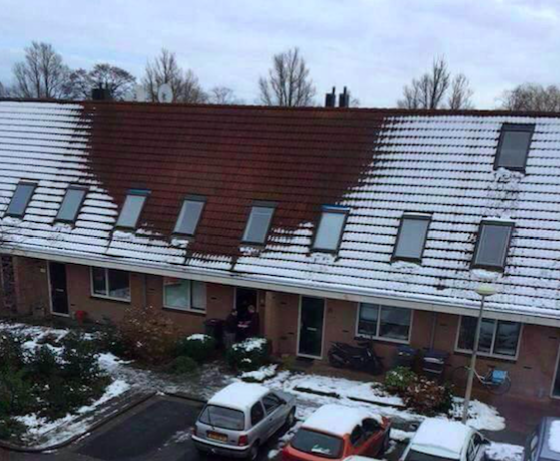Snow Reason to Think a Crime is Underway
If you’re going to do something illegal — and please, don’t take this as an invitation to do so — it’s best to do so behind closed doors. If you’re open and notorious about your criminal activity, you are almost certainly going to get caught, and that’s literally the opposite of your goal. But unless the police have a warrant or x-ray vision or something like that, you’re less likely to be caught if you’re indoors, with shades drawn, and the like. In general, the walls of your house, apartment, or shady warehouse down by the docks will shield your evil deeds from the eyes of the law.
But under the right conditions, the roof may give you away.
When it gets cold enough outside, there’s this thing called snow that falls from the skies. The Oxford Dictionaries define “snow” as “atmospheric water vapor frozen into ice crystals and falling in light white flakes or lying on the ground as a white layer,” and while you already knew that, the important part is the word “frozen.” Snow is cold, and has to be cold; otherwise, it goes away. And just how cold matters. As the National Snow and Ice Data Center explains, “snow forms when the atmospheric temperature is at or below freezing (0 degrees Celsius or 32 degrees Fahrenheit)” and will “not form if the ground temperature is at least 5 degrees Celsius (41 degrees Fahrenheit).”
Roofs aren’t all that different than the ground in that case. If for some reason, your roof is too warm, the snow will just melt right off of it. Take, for example, the picture below.

See? A snowy roof — but with a semicircle patch that’s basically snow-free. That’s a tell-tale sign of a heat source.
And in this case, it was enough to get a search warrant. The Telegraph explained:
Police in the Netherlands have swooped on a house in the town of Haarlem, arresting the owner for growing cannabis plants, after they noticed that his house was the only one in the street not covered in snow.
A dusting of snow-covered all the roofs in the town, except for one.
Once inside, police found industrial-scale cultivation of cannabis, and the heat lamps used to nurture the plants.
While small-scale cannabis cultivation is legal in the Netherlands, larger operations like this one — the exact number of plants went unreported — exceeded the allowed limit of five. And apparently, the telltale snow wasn’t a unique feature of this drug bust. Again per the Telegraph, “the previous week, officials had used the same technique to identify and raid a cannabis farm in the city of Zutphen, where they found a bedroom filled with 88 marijuana plants. Two days later, one person was arrested in Arnhem after police discovered a similar plantation.”
In fact, the tactic became so popular that we got to learn about it. The image above actually comes from the official Twitter account of the police force of Delft. Here’s the tweet, and translated, it read “Take a look at the roofs in your neighborhood. No snow? Possible hemp farm,” with a phone number to call if you’d like to turn your neighbors in for having a snow-free roof.
Of course, you do so at some risk. There’s a good chance that a heat source has a totally innocent explanation, as Dutch police discovered a few months earlier. Per another Telegraph report, sometimes, the pot farm you expect to find turns out to just be a wood-burning stove.
Bonus fact: Shoveling snow can be dangerous. Every year, about 100 Americans die from heart attacks caused by clearing their driveways or walkways. Before 2017, a research team led by cardiologist Barry Franklin investigated why and found that the activity, combined with the environment, created a perfect storm for cardiac woes. Per the BBC, Franklin and team “found that when healthy young men shoveled snow, their heart rate and blood pressure increased more than when they exercised on a treadmill,” and if you “combine this with cold air, which causes arteries to constrict and decrease blood supply, you have a perfect storm for a heart attack.”
From the Archives: How Some Places are Beeting the Snow: Not a typo.
